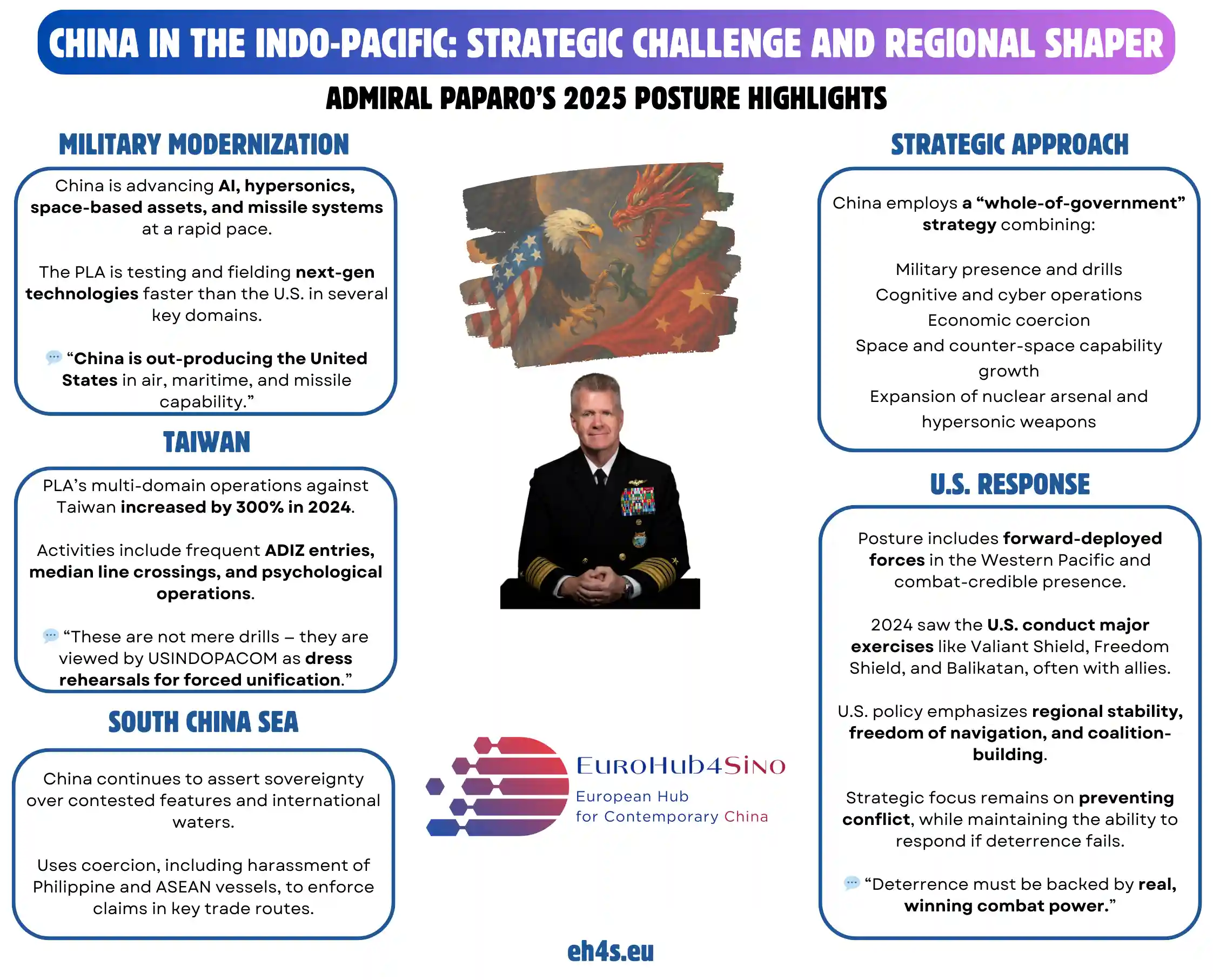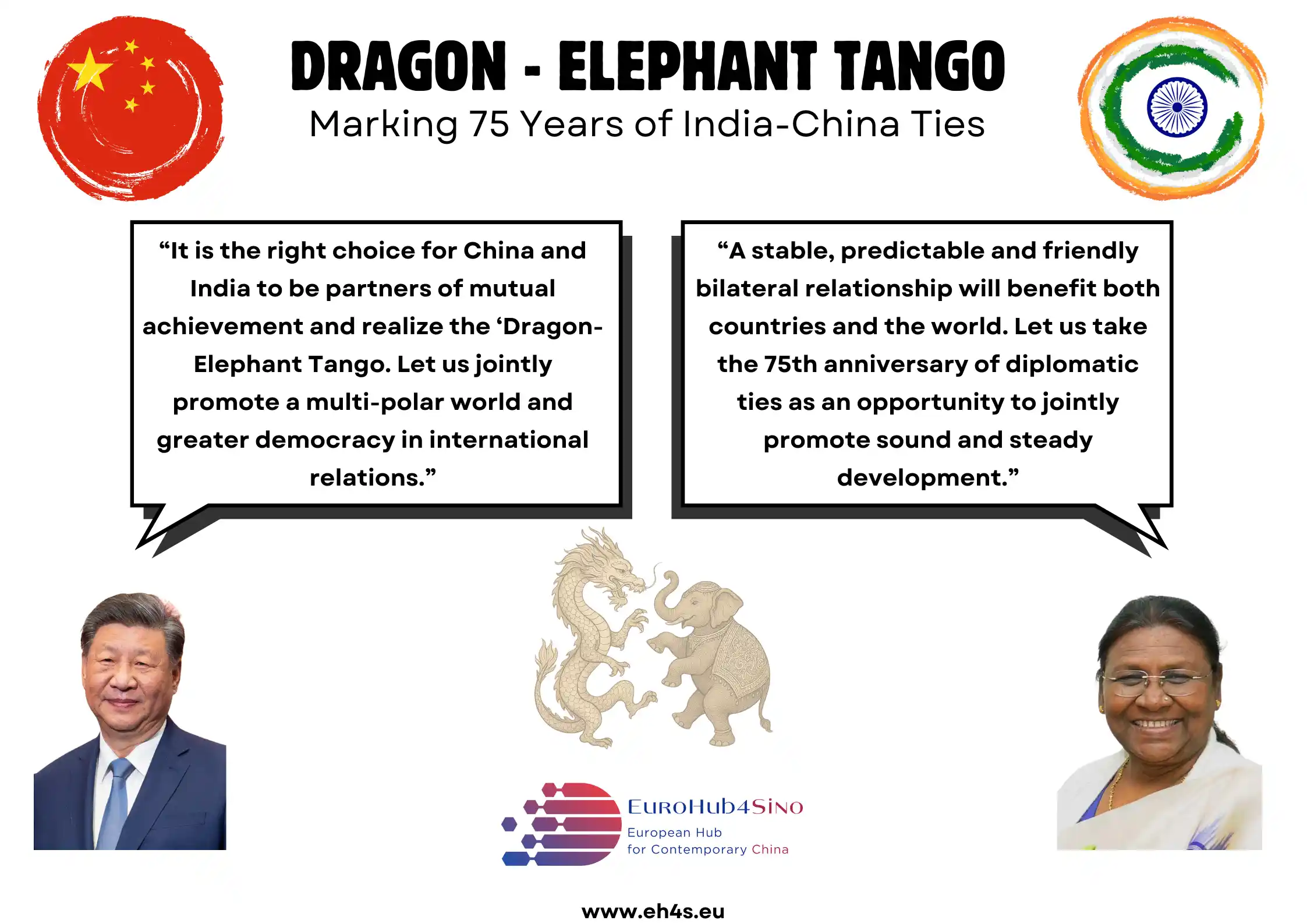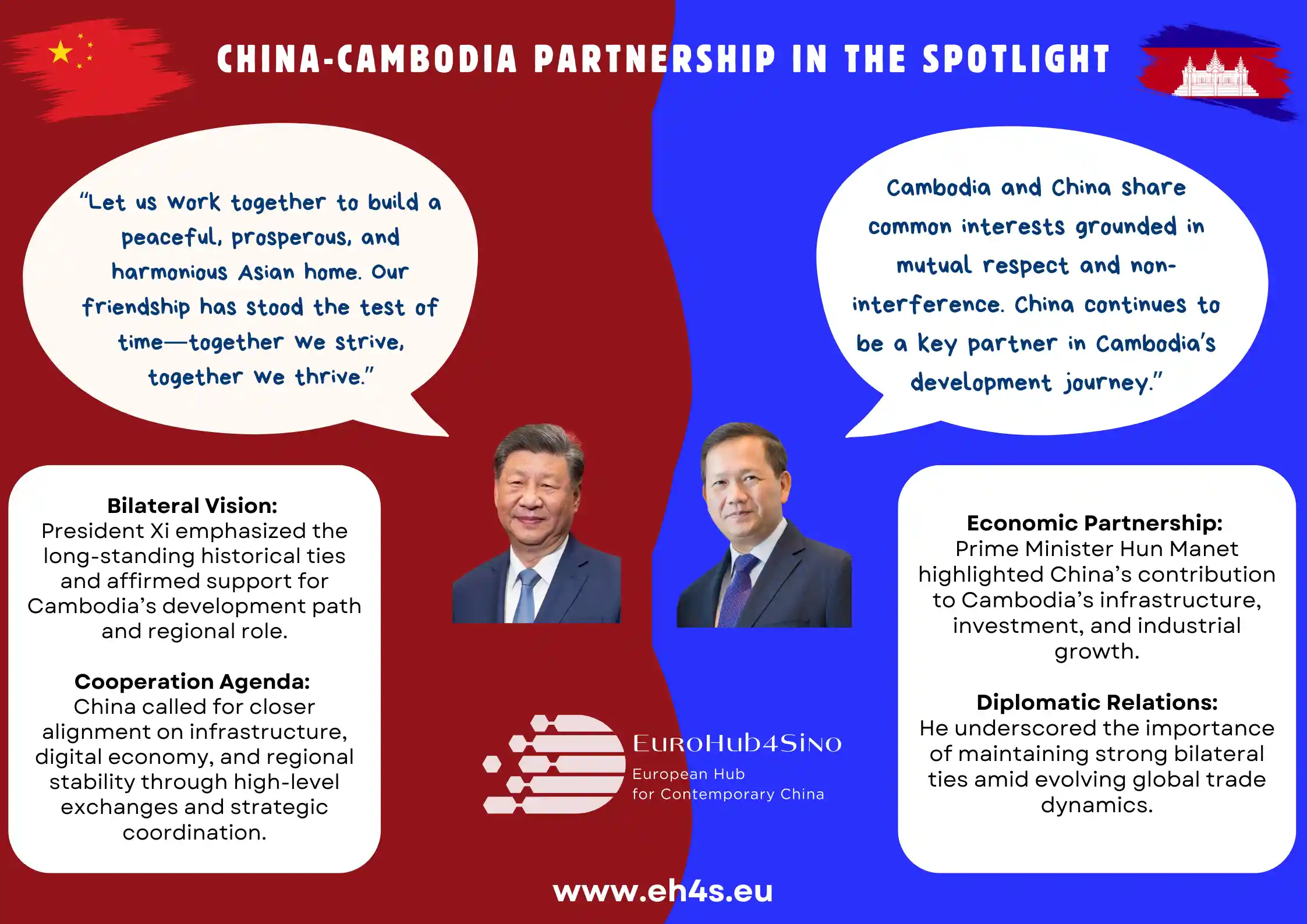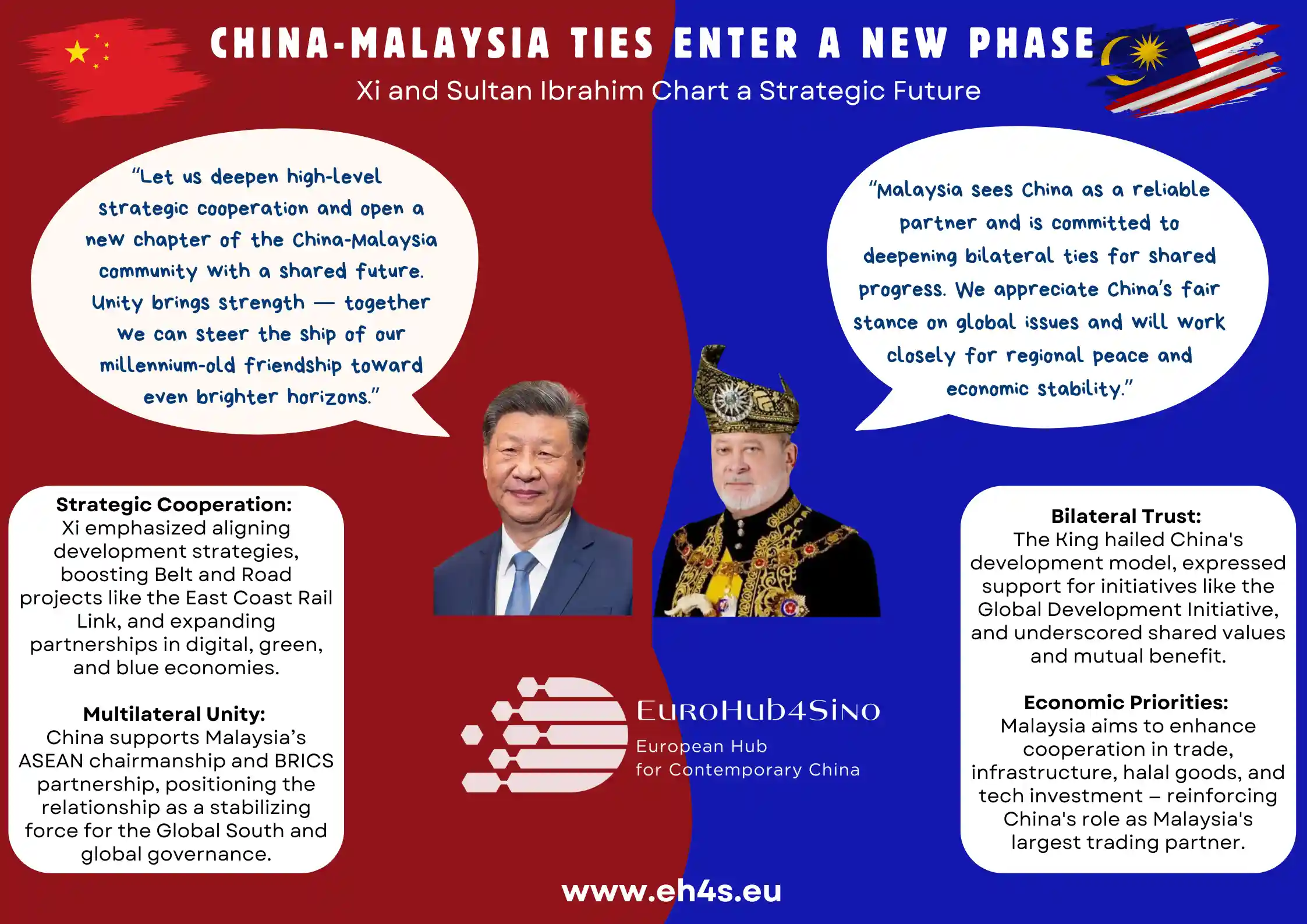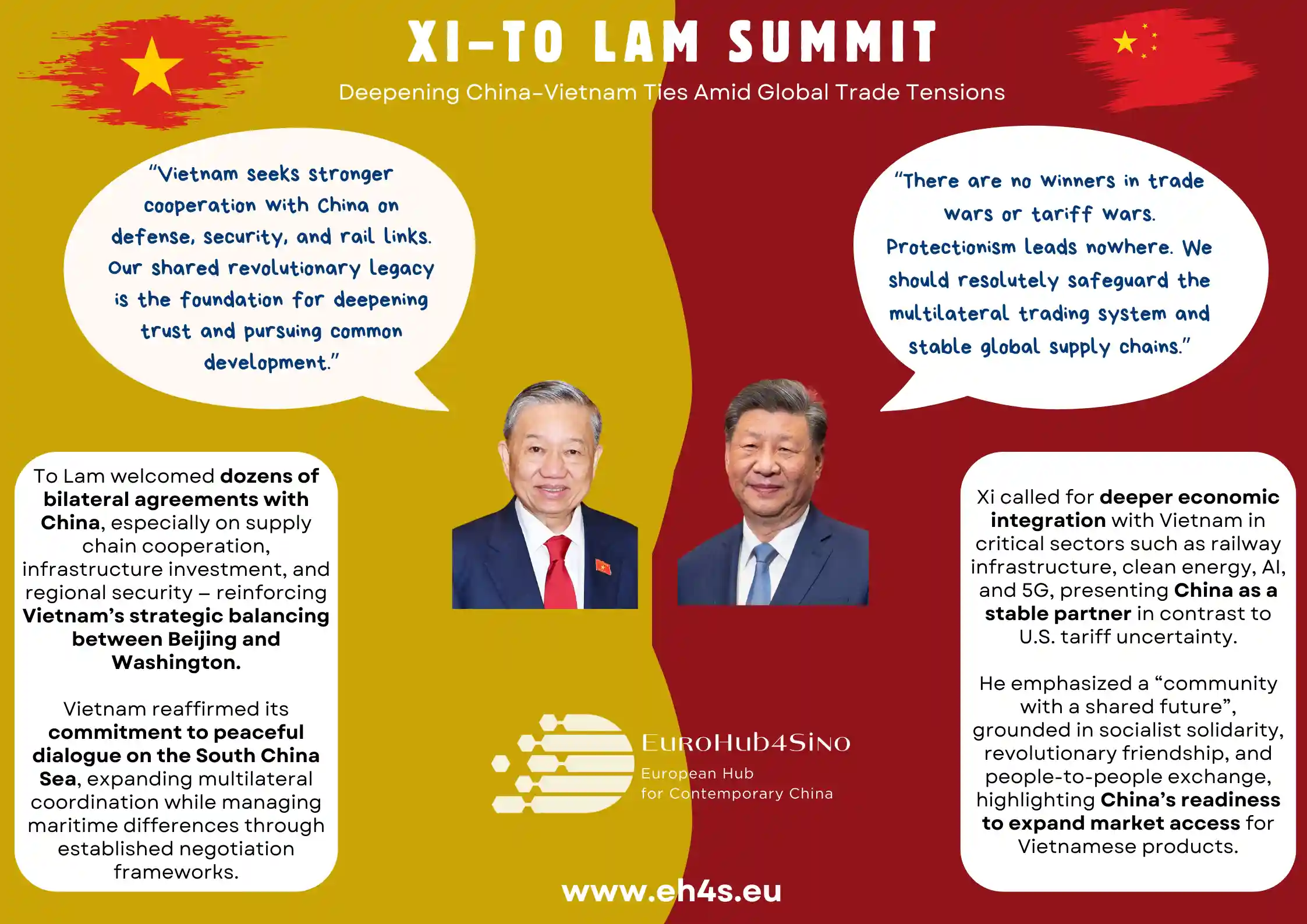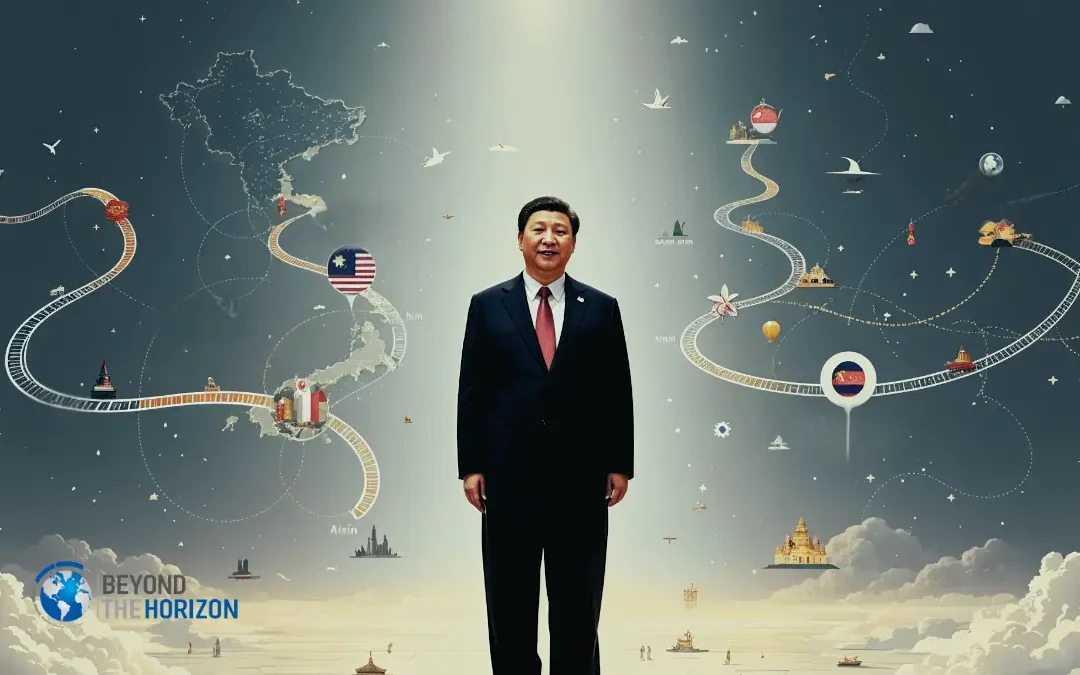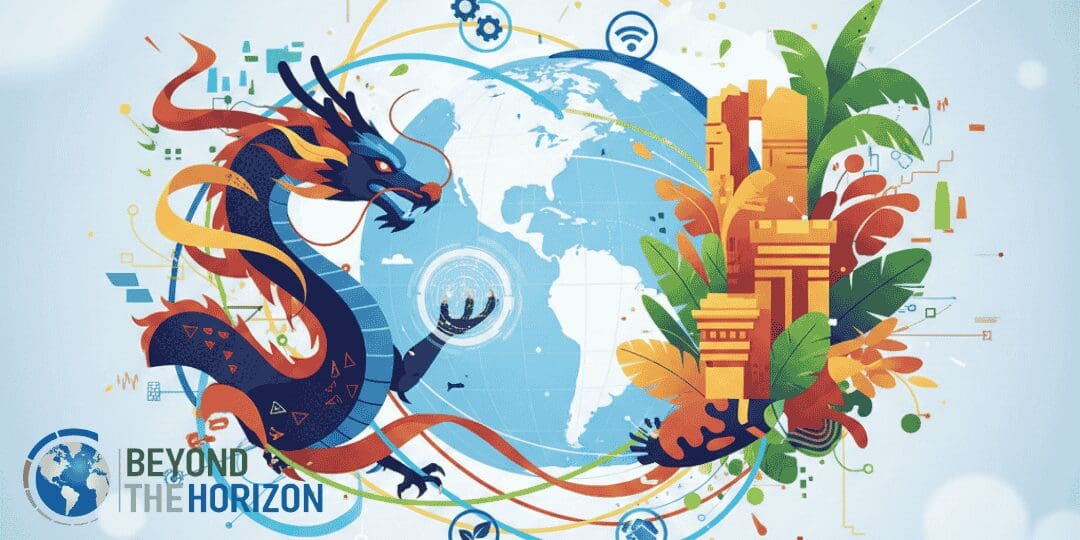Key Takeaways
- Xi Jinping’s April 2025 Southeast Asia tour marks a strategic deepening of China’s neighborhood diplomacy, with visits to Vietnam, Malaysia, and Cambodia showcasing Beijing’s evolving model of personalized, high-level engagement with the Global South.
- The tour exemplifies China’s “head-of-state diplomacy,” a foreign policy approach centered on Xi himself as the architect and executor of China’s external strategy. This model prioritizes trust-building with selected partners through fewer but more targeted and symbolic overseas visits.
- In Vietnam, ideological affinity and party-to-party solidarity formed the core of engagement, as China and Vietnam elevated defense dialogue, reaffirmed Belt and Road cooperation, and pledged joint development in the South China Sea while opposing external interference.
- Malaysia offered a platform for strategic economic modernization, with Xi promoting high-tech cooperation, infrastructure connectivity, and regional leadership within ASEAN. The alignment of Malaysia’s development strategy with Belt and Road goals highlighted China’s ability to forge pragmatic partnerships with middle powers.
- Cambodia emerged as a showcase of loyalty-based asymmetry, where historical legacy, political trust, and security cooperation underpin an “all-weather” community with a shared future. Over 30 bilateral agreements were signed, including on digital governance, infrastructure, and combating transnational crime.
- The tour underscored the integration of symbolic diplomacy with operational defense outreach, as China’s Central Military Commission and Defense Minister Dong Jun expanded military engagements across the Global South—complementing Xi’s high-level messaging with concrete security partnerships.
- China’s differentiated approach to regional partners is becoming more coherent: ideological allies receive regime-level coordination, middle powers get investment and tech collaboration, and small loyal states gain deepened security and development ties.
- Across all three visits, Xi promoted a vision of multipolarity rooted in sovereignty, non-interference, and development-first diplomacy, contrasting with perceived Western pressure and bloc-based alignment.
- The success of China’s strategy depends on delivering material benefits, managing tensions in contested spaces, and navigating the balancing acts of Southeast Asian nations, many of which continue to hedge between great powers.
- Ultimately, the tour represents China’s bid to shape a new regional order from within, offering its neighbors an alternative model of partnership—grounded in historical ties, strategic alignment, and a shared future on China’s terms.
Introduction
In April 2025, Chinese President and Communist Party General Secretary Xi Jinping embarked on a rare but symbolically potent tour of Southeast Asia, visiting Vietnam, Malaysia, and Cambodia. This carefully choreographed itinerary marked not only Xi’s first overseas trip of the year, but also the continuation of a foreign policy shift that has come to define China’s evolving international engagement strategy—what Beijing has termed “head-of-state diplomacy.” Introduced formally in 2023, this approach elevates the personal role of Xi as China’s chief diplomat, underscoring the centralization of foreign policymaking within the party-state and the projection of Xi as the singular face of Chinese global leadership.
Unlike the more frequent diplomatic forays seen during Xi’s first two terms—when the Chinese leader averaged 14 international trips per year between 2013 and 2019—this new approach trades quantity for strategic impact. The focus is now on consolidating relationships with priority partners in the Global South, particularly those with geopolitical, economic, and ideological significance to China’s vision of a multipolar world. In this sense, Southeast Asia stands as a frontline region: economically interdependent with China, deeply integrated in Belt and Road infrastructure, yet geopolitically contested amid intensifying U.S.-China competition.
Xi’s 2025 Southeast Asia tour exemplifies this recalibrated diplomacy. Each stop reinforced specific goals: in Vietnam, the shared revolutionary past and socialist trajectory were invoked to deepen political trust and security cooperation; in Malaysia, the emphasis was on supply chain integration and digital economy collaboration; in Cambodia, long regarded as China’s most reliable ally in ASEAN, the visit further strengthened defense and regime support. Beyond bilateral relations, the trip was also a strategic signal: that China remains committed to shaping its regional environment according to its norms, interests, and development model —despite headwinds of protectionism, global volatility, and rising skepticism toward Chinese power.
Moreover, this tour did not take place in isolation. It was accompanied by a surge in military and defense diplomacy led by China’s Central Military Commission (CMC) and Defense Minister Dong Jun. While Xi’s visits served as the symbolic pinnacle of Chinese foreign policy, CMC officials conducted dozens of bilateral and multilateral engagements in the Global South throughout 2024, further entrenching China’s security footprint. Together, these developments represent a dual-track strategy: high-level political assurance paired with expanding defense cooperation.
This analysis examines the contours and implications of Xi Jinping’s Southeast Asia tour. It explores the diplomatic narratives advanced by China, assesses the strategic objectives of the visits to Vietnam, Malaysia and Cambodia, and situates them within the broader context of China’s head-of-state and military diplomacy. Ultimately, it argues that this tour reflects not only Beijing’s determination to secure its regional periphery, but also its ambition to embed Chinese norms, practices, and partnerships deeper into the fabric of the Global South.
Vietnam: Reinforcing Revolutionary Brotherhood and Strategic Resilience
Vietnam was the centerpiece of Xi Jinping’s April 2025 Southeast Asia tour, both symbolically and substantively. Marking the 75th anniversary of China-Vietnam diplomatic ties, the visit was saturated with political messaging that highlighted ideological alignment, historical solidarity, and forward-looking cooperation under the banner of a “community with a shared future that carries strategic significance.” It was also Xi’s fourth visit to Vietnam as China’s top leader—underscoring the enduring weight Beijing attaches to this bilateral relationship in its broader neighborhood diplomacy.
From the outset, Xi framed the visit in civilizational and revolutionary terms. In his signed article for Nhan Dan, he invoked the shared legacy of resistance against imperialism, wartime solidarity, and the historic motto: “We are both comrades and brothers.” These references were more than nostalgic—they served to reinforce political legitimacy and to anchor present-day cooperation in a deep reservoir of revolutionary trust, particularly important at a time when both countries are navigating domestic modernization under single-party rule.
During the state visit, Xi held a series of high-level meetings with Vietnam’s top leadership, including General Secretary To Lam, President Luong Cuong, Prime Minister Pham Minh Chinh, and National Assembly Chairman Tran Thanh Man. Across these meetings, five interlocking themes defined the strategic upgrade in bilateral ties:
Deepening Political and Ideological Alignment
China and Vietnam pledged to strengthen party-to-party ties, state governance exchanges, and strategic communications. Notably, both sides emphasized the political role of top-level diplomacy in steering socialist modernization, a shared ambition grounded in the ideological language of Marxism-Leninism but increasingly informed by pragmatic economic adaptation. Xi proposed frequent leader-level engagements “like family,” while To Lam lauded Xi as a “great friend of the Vietnamese people,” reaffirming Vietnam’s commitment to the one-China policy and its support for China’s core interests on Taiwan, Xinjiang, and Hong Kong.
Security and Defense Cooperation Upgraded
One of the most significant outcomes of the visit was the institutional elevation of the “3+3” dialogue mechanism—covering diplomacy, defense, and public security—to the ministerial level. This structural upgrade complements growing cooperation on law enforcement and counter-crime coordination, especially in tackling cross-border telecom fraud and illegal online gambling. More broadly, it reflects China’s interest in integrating Vietnam more tightly into its regional security architecture, particularly within frameworks like the Lancang-Mekong Cooperation.
Economic Integration and Connectivity
Economically, China reaffirmed its role as Vietnam’s largest trading partner—with bilateral trade exceeding $260 billion in 2024—and announced new initiatives in infrastructure and technology. These included expanding cooperation on standard-gauge railways, advancing smart port development, and deepening partnerships in artificial intelligence, clean energy, and 5G. Vietnam, for its part, emphasized its openness to greater Chinese investment—albeit cautiously, given persistent concerns over dependency and transparency.
The two sides also committed to aligning China’s Belt and Road Initiative with Vietnam’s “Two Corridors and One Economic Circle” strategy, a long-standing but previously under-delivered vision. Whether these synergies translate into accelerated project delivery remains a key test of the partnership’s credibility.
People-to-People Diplomacy and Cultural Soft Power
The 2025 “China-Vietnam Year of People-to-People Exchanges” provided a cultural backdrop for the visit. Xi and To Lam jointly launched a “red study tour” program, targeting Vietnamese youth with trips to revolutionary sites in China. The symbolism is clear: the long-term durability of China-Vietnam relations depends not only on leaders and institutions, but also on cultivating sentiment among younger generations. Tourism, educational exchanges, and digital cultural diffusion—such as the popularity of Vietnamese music in China and vice versa—are increasingly tools of influence in this space.
Managing Differences in the South China Sea
Perhaps the most delicate topic was maritime disputes in the South China Sea. Xi emphasized the importance of “constructive maritime engagement” and called for full implementation of the Declaration on the Conduct of Parties, alongside acceleration of talks on a Code of Conduct. Importantly, both sides committed to handling disputes bilaterally—an implicit rebuke to multilateral or third-party mediation—and highlighted joint development as a viable path forward. The joint call for resisting external interference echoed Beijing’s growing frustration with U.S. freedom of navigation operations in contested waters.
Malaysia: Engineering Strategic Alignment for a “Golden 50 Years”
Malaysia, the second leg of Xi Jinping’s Southeast Asia tour, provided a contrasting yet complementary dimension to China’s regional strategy. While Vietnam offered a narrative steeped in ideological brotherhood and revolutionary history, Malaysia presented a platform for showcasing pragmatic cooperation, future-oriented economic integration, and regional leadership within ASEAN. This was Xi’s first visit to Malaysia in 12 years and came just months after both countries celebrated the 50th anniversary of diplomatic ties and committed to building a “high-level strategic community with a shared future.”
Against the backdrop of China’s intensifying outreach to the Global South, the visit served multiple objectives: solidifying China’s economic footprint, positioning Malaysia as a partner in emerging technologies and supply chains, and reinforcing ASEAN’s centrality—with Malaysia cast as both interlocutor and facilitator.
Framing a “Shared Future” in the Language of Civilization and Sovereignty
In his signed article for Malaysian outlets Sin Chew Daily, The Star, and Sinar Harian, Xi invoked a millennia-old history of maritime exchange and civilizational harmony. He referenced Tang-era monk Yijing, Ming explorer Zheng He, and Malaysia’s wartime solidarity with China to craft a narrative of mutual support that transcends contemporary politics. The symbolism was deliberate: Malaysia is not merely a trading partner—it is a co-civilizational actor in the broader project of Asia’s rejuvenation.
During his meetings with King Sultan Ibrahim and Prime Minister Anwar Ibrahim, Xi emphasized mutual respect for sovereignty, political systems, and development paths—an implicit rebuke to what both governments perceive as Western moralizing in foreign policy. Malaysia reaffirmed its commitment to the One China policy, and in a notable gesture, agreed to deepen dialogue on defense and foreign policy via a newly established Joint Foreign and Defense Dialogue Mechanism.
Economic Integration and High-Quality Cooperation
Economic diplomacy dominated the visit’s deliverables. China and Malaysia agreed to accelerate the implementation of the Belt and Road Cooperation Plan signed in 2024, with priority given to infrastructure connectivity and industrial upgrading. Key focus areas included:
Flagship Projects: The East Coast Rail Link, one of the most high-profile Belt and Road projects in Southeast Asia, was reaffirmed as a strategic priority. Both sides also committed to upgrading the “Two Countries, Twin Parks” initiative linking Kuantan and Qinzhou as models of industrial cooperation.
Supply Chain Resilience: China pledged deeper integration of industrial, supply, data, and talent chains. The goal is to create “new quality productive forces,” with an emphasis on strategic sectors such as green energy, logistics, digital services, and AI.
Emerging Technologies: Malaysia welcomed Chinese participation in 5G development, smart city initiatives, and the semiconductor value chain—areas where the U.S.-China tech rivalry casts a long shadow. China’s ability to offer competitive alternatives to Western infrastructure and digital ecosystems gives it an edge in courting Malaysia’s interest.
Bilateral trade between China and Malaysia reached $212 billion in 2024—nearly a thousand-fold increase from the inception of ties in 1974—making China Malaysia’s top trading partner for 16 consecutive years. The visit reaffirmed both countries’ intent to build on this momentum through a Five-Year Programme for Economic and Trade Cooperation (2024–2028).
ASEAN Centrality and the Global South Narrative
As incoming ASEAN chair and country coordinator for China-ASEAN Dialogue Relations in 2025, Malaysia occupies a key position in China’s regional diplomacy. Xi’s visit highlighted this explicitly. He positioned China-Malaysia relations as a cornerstone of broader China-ASEAN cooperation, noting that ASEAN-China trade surpassed $980 billion in 2024 and that negotiations for an upgraded China-ASEAN Free Trade Area (Version 3.0) had been substantively concluded.
Malaysia’s inclusion in BRICS as a partner country also featured prominently in the visit, symbolizing what both governments see as a shifting global order. Xi underscored the Bandung Spirit and the Five Principles of Peaceful Coexistence, while Anwar embraced the rhetoric of Global South solidarity. Both sides affirmed support for the Global Development Initiative, Global Security Initiative, and Global Civilization Initiative—pillars of China’s normative push for alternative global governance frameworks.
Cultural and Human Connectivity
Cultural diplomacy and people-to-people exchanges were also prominent. With reciprocal visa waivers in place, nearly six million mutual visits occurred between China and Malaysia in 2024—surpassing pre-pandemic levels. Xi noted this dynamic as an engine of “soft power diplomacy,” referencing tourism slogans like “Malaysia, Truly Asia” as symbols of mutual curiosity and cultural warmth.
Plans for expanding educational exchange, Confucian-Islamic cultural dialogue, and cooperation on Halal industries and space exploration were also part of the agenda. These initiatives aim to humanize bilateral ties and build long-term affinity—particularly among youth and civil society stakeholders.
Cambodia: Forging an All-Weather “Community with a Shared Future”
The final stop on Xi Jinping’s April 2025 Southeast Asia tour brought him to Cambodia, China’s most reliable and enthusiastic partner in mainland Southeast Asia. The visit coincided with the Khmer New Year, offering both symbolic warmth and strategic purpose. Through carefully choreographed ceremonies, signed articles, and high-level talks, Xi reinforced what he called an “ironclad friendship” and elevated China-Cambodia ties to an “all-weather community with a shared future in the new era.”
Xi’s engagements in Phnom Penh—featuring meetings with King Norodom Sihamoni, Prime Minister Hun Manet, Senate President Hun Sen, and Queen Mother Monineath—unfolded as a diplomatic affirmation of loyalty, legacy, and long-term alignment. As Xi put it in his article published in leading Cambodian outlets, “Together We Strive, Together We Thrive,” the China-Cambodia relationship is a product of “history and the people,” and now stands as a model of Global South partnership rooted in equality, mutual benefit, and shared destiny.
Legacy, Sovereignty, and Political Endorsement
The visit was steeped in historical memory. Xi paid tribute to King Father Norodom Sihanouk, who forged close ties with Mao Zedong and Zhou Enlai during the Cold War. He hailed Queen Mother Monineath as a symbol of continuity and presented her as a personal friend of China. These gestures were designed not merely to honor the past, but to frame the current generation of Cambodian leadership—particularly Hun Sen and Hun Manet—as inheritors of a historic mission to safeguard national sovereignty with China’s support.
China reiterated its unwavering endorsement of Cambodia’s political independence and development path. Xi emphasized opposition to “external interference,” “color revolutions,” and “bloc confrontation,” positioning China as a partner in safeguarding Cambodia’s regime stability and strategic autonomy.
Strategic Synergy and Economic Integration
Cambodia has become a crucial node in China’s expanding military diplomacy in the Global South. In 2024, China and Cambodia completed major upgrades to the Ream Naval Base on the Gulf of Thailand—projects that drew concern from the United States and regional actors due to their potential dual-use nature. While Cambodian authorities have denied granting China exclusive access, satellite imagery and defense sources suggest significant Chinese involvement in the facility’s construction and design.
A core deliverable of the visit was the alignment of China’s Belt and Road Initiative with Cambodia’s Pentagonal Strategy for national development. Xi called for faster implementation of the “Industrial and Technological Corridor” and the “Fish and Rice Corridor”—two flagship initiatives aimed at boosting agricultural productivity, rural livelihoods, and industrial modernization. He also pledged enhanced cooperation in advanced manufacturing, digital economy, green development, and AI.
The “Diamond Hexagon” cooperation framework—covering six strategic sectors including politics, production capacity, agriculture, energy, security, and people-to-people exchange—was reaffirmed and upgraded. Over 30 bilateral agreements were signed, encompassing areas like customs, development assistance, health, telecom, and AI regulation. Xi also encouraged more Chinese investment and greater imports of Cambodian agricultural products like longan and mango, pledging broader access to China’s mega-market.
Chinese-supported infrastructure remains central to the relationship. The Phnom Penh–Sihanoukville Expressway, Cambodia’s first, was cited as a symbol of success. The Sihanoukville Special Economic Zone, with over 200 companies in operation, was hailed as a prototype for Belt and Road industrial cooperation in the Global South.
Security Cooperation and “2+2” Dialogue
Security featured more prominently in Xi’s Cambodia visit than in previous years. Both countries agreed to make operational the new “2+2” strategic dialogue mechanism involving their foreign and defense ministers. Discussions focused on enhancing coordination in counterterrorism, emergency response, joint drills, and the protection of major Belt and Road projects.
Xi urged a joint stand against “telecom fraud,” “online gambling,” and “external destabilization efforts,” and called for deeper collaboration in combatting transnational crime. This reflects China’s broader ambition to export its domestic stability paradigm to willing partners, blending digital surveillance, intelligence cooperation, and public order frameworks.
People-to-People and Civilizational Diplomacy
Cultural and educational diplomacy was emphasized throughout the visit. Xi announced the launch of the 2025 China-Cambodia Year of Tourism, pledged expanded government scholarships for Cambodian students, and encouraged new local-level partnerships and youth dialogue mechanisms. He celebrated joint restoration efforts at Angkor’s temples as a metaphor for the two nations’ shared civilizational heritage, noting centuries of Buddhist, artistic, and maritime exchange.
At the grassroots level, China has funded thousands of clean water wells, friendship villages, and public health projects in Cambodia. Xi referenced personal stories—such as a hearing-impaired girl speaking for the first time after treatment by Chinese doctors—as a humanizing narrative of the bilateral relationship.
Conclusion: A Blueprint for Regional Influence in a Multipolar Era
Xi Jinping’s April 2025 tour of Vietnam, Malaysia, and Cambodia was more than a diplomatic routine—it was a declaration of intent. Through high-level symbolism, personalized diplomacy, and strategic deliverables, Xi laid out a blueprint for a China-centric regional order, built not on military alliances or ideological expansion, but on sovereign respect, political alignment, and economic interdependence. This approach, encapsulated in China’s “head-of-state diplomacy” doctrine, seeks to rewire neighborhood relations around a narrative of shared modernization, historical friendship, and post-Western global governance.
What distinguished this tour was its layered precision. In Vietnam, Xi emphasized ideological affinity and regime solidarity, reinforcing shared socialist roots while expanding security and digital cooperation. In Malaysia, the message was pragmatic and economic—focusing on technological integration, resilient supply chains, and ASEAN centrality. In Cambodia, China’s model of loyalty-based asymmetry came into full view: a relationship where political trust and historical gratitude are leveraged to deepen strategic influence and reinforce China’s vision of multipolarity.
Together, the three visits revealed a diplomatic playbook that is adaptable, durable, and increasingly coherent:
- Ideological partners are offered political synchronization and institutional learning.
- Middle-power states receive tailored economic partnerships and leadership recognition.
- Loyal small states are elevated through security guarantees and public diplomacy.
The common denominator across all three? The framing of China as a benevolent and steadfast partner in a chaotic world—one that does not demand allegiance to values, but to interests and sovereignty.
This tour also illustrated the synergy between China’s civilian and military diplomacy. While Xi met with kings and prime ministers, the Central Military Commission and Defense Minister Dong Jun continued their expansive outreach to Global South militaries—advancing dialogues, conducting joint trainings, and offering alternative security paradigms. The military component isn’t separate from head-of-state diplomacy—it’s its operational arm.
But Xi’s strategy is not without friction. In places like Vietnam and Malaysia, hedging remains a core instinct. Engagement with the United States, Japan, and India continues, and doubts over China’s intentions—especially in the maritime domain—have not vanished. Moreover, the sustainability of loyalty-based relationships like Cambodia’s depends on elite continuity and economic outcomes, both of which may evolve over time.
Still, what Xi’s 2025 tour demonstrates is that China is not passively reacting to great power competition—it is actively designing a new diplomatic architecture from within its neighborhood. It is shaping norms, agendas, and narratives—one signed article, strategic corridor, and joint declaration at a time.
As the Indo-Pacific becomes the fulcrum of global transformation, China’s bet is clear: that it can outlast, out-connect, and out-influence its competitors—not by replacing the current system, but by offering an alternative that feels more credible, inclusive, and achievable to its closest neighbors.
Whether that bet succeeds will depend on Beijing’s ability to deliver real benefits, manage asymmetric expectations, and prove that its partnerships can endure not only turbulent times—but also the test of time itself.
Related Infographics
